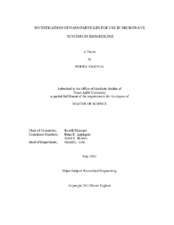| dc.description.abstract | This research focuses on the microwave properties of nanoparticles for use as contrast and hyperthermia agents. Currently, visible light is used for irradiation of nanoparticles as hyperthermia agents. Additionally, visible/Near-infrared light is used for photoacoustic tomography (PAT) imaging. Compared to optical wavelengths, frequencies in microwave range transmit through tissue with high penetration depth . Thus, deep cancerous cells and malignant tissue may be treated and imaged. These nanoparticles could enable the use of a hybrid microwave/acoustic technique known as thermoacoustic tomography.
Here, quantitative measurements of the heat generation in super paramagnetic iron oxide nanoparticle (SPIONs), gold nanoparticles (AuNPs), and gold nanoclusters (AuNCs) induced by microwave energy at 3 GHz, are presented and compared. Based on our experiments, SPIONs are the most efficient nanoparticles for microwave heating. Very high concentrations of SPIONs are able to convert microwave energy into heat about 22° C more than DI-water. AuNPs, which support plasmon resonances, do not provide heat under microwave irradiation as predicted by our computational analysis based on Mie Theory. AuNCs are a new form of ultra-small (<2.5 nm) AuNPs which do not support plasmonic resonances and have supra-molecular properties such as sub-conduction band transitions. Interestingly, AuNCs have the potential to absorb microwave energy and may provide an alternative to SPIONs. These nanoparticles had not yet been studied before in this frequency region. In addition, the absorption coefficient of nanoparticles were calculated using complex permittivity data from a dip probe kit and a Vector Network Analyzer (VNA) in a broad band range from 500 MHZ to 10 GHz. This method allows identification of best frequency region with highest penetration depth. In the last step, the nanoparticles with different concentrations were tested as exogenous contrast agents in a Thermoacoustic Tomography (TAT) system. TAT utilizes the penetration depth of microwave energy while producing high resolution images through acoustic waves. The addition of an exogenous contrast agent improves image quality by more effectively converting microwave energy to heat. The experiment reveals that the time resolved thermoacoustic signal (TA) from SPIONs is stronger than AuNPs and AuNCs and thus, the image contrast produced by SPIONs is stronger than the two other aforementioned nanoparticles. | en |


